Clinical Reasoning Cycle Case Study: Analyzing Ted's Health Challenges
VerifiedAdded on 2022/07/28
|11
|2924
|32
Case Study
AI Summary
This case study analyzes the health challenges of Ted, an 82-year-old patient, focusing on the application of the clinical reasoning cycle. The assignment delves into Ted's biological, psychological, social, and spiritual background, highlighting his history of diabetes, colon cancer, hypertension, and gout. The case study meticulously examines the process information stage, identifying key health concerns such as colon cancer, type 2 diabetes, hypertension, and gout, along with their associated risk factors. The interventions section proposes various strategies, including surgical interventions, patient education, physical exercises, dietary changes, and medication, to address Ted's multiple health problems. The assignment also discusses the use of analgesics and anticoagulants, essential medications for post-operative care. References are provided to support the analysis and interventions discussed. This case study is designed to demonstrate the student's ability to apply the clinical reasoning cycle to a complex patient scenario and propose evidence-based interventions.
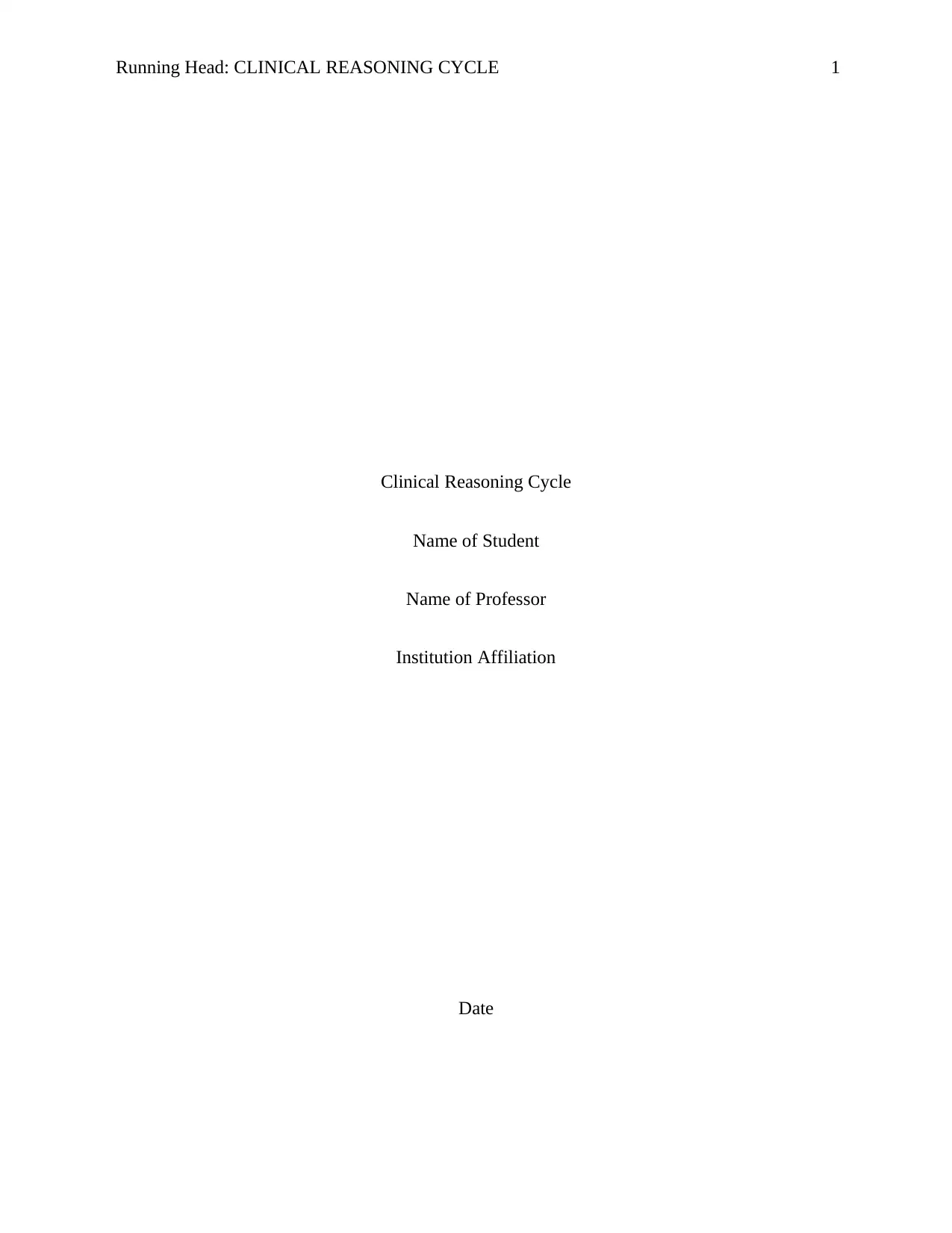
Running Head: CLINICAL REASONING CYCLE 1
Clinical Reasoning Cycle
Name of Student
Name of Professor
Institution Affiliation
Date
Clinical Reasoning Cycle
Name of Student
Name of Professor
Institution Affiliation
Date
Paraphrase This Document
Need a fresh take? Get an instant paraphrase of this document with our AI Paraphraser
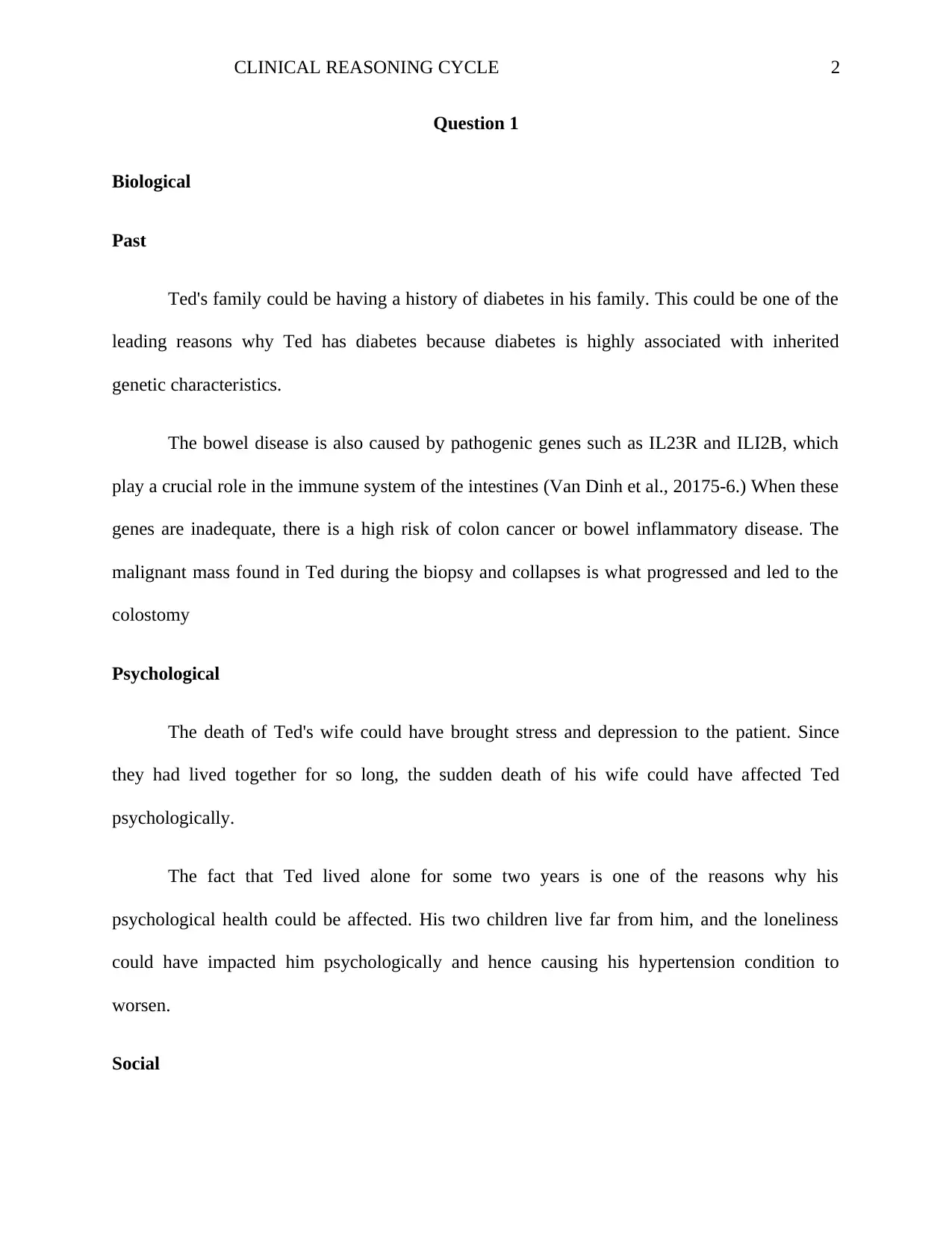
CLINICAL REASONING CYCLE 2
Question 1
Biological
Past
Ted's family could be having a history of diabetes in his family. This could be one of the
leading reasons why Ted has diabetes because diabetes is highly associated with inherited
genetic characteristics.
The bowel disease is also caused by pathogenic genes such as IL23R and ILI2B, which
play a crucial role in the immune system of the intestines (Van Dinh et al., 20175-6.) When these
genes are inadequate, there is a high risk of colon cancer or bowel inflammatory disease. The
malignant mass found in Ted during the biopsy and collapses is what progressed and led to the
colostomy
Psychological
The death of Ted's wife could have brought stress and depression to the patient. Since
they had lived together for so long, the sudden death of his wife could have affected Ted
psychologically.
The fact that Ted lived alone for some two years is one of the reasons why his
psychological health could be affected. His two children live far from him, and the loneliness
could have impacted him psychologically and hence causing his hypertension condition to
worsen.
Social
Question 1
Biological
Past
Ted's family could be having a history of diabetes in his family. This could be one of the
leading reasons why Ted has diabetes because diabetes is highly associated with inherited
genetic characteristics.
The bowel disease is also caused by pathogenic genes such as IL23R and ILI2B, which
play a crucial role in the immune system of the intestines (Van Dinh et al., 20175-6.) When these
genes are inadequate, there is a high risk of colon cancer or bowel inflammatory disease. The
malignant mass found in Ted during the biopsy and collapses is what progressed and led to the
colostomy
Psychological
The death of Ted's wife could have brought stress and depression to the patient. Since
they had lived together for so long, the sudden death of his wife could have affected Ted
psychologically.
The fact that Ted lived alone for some two years is one of the reasons why his
psychological health could be affected. His two children live far from him, and the loneliness
could have impacted him psychologically and hence causing his hypertension condition to
worsen.
Social
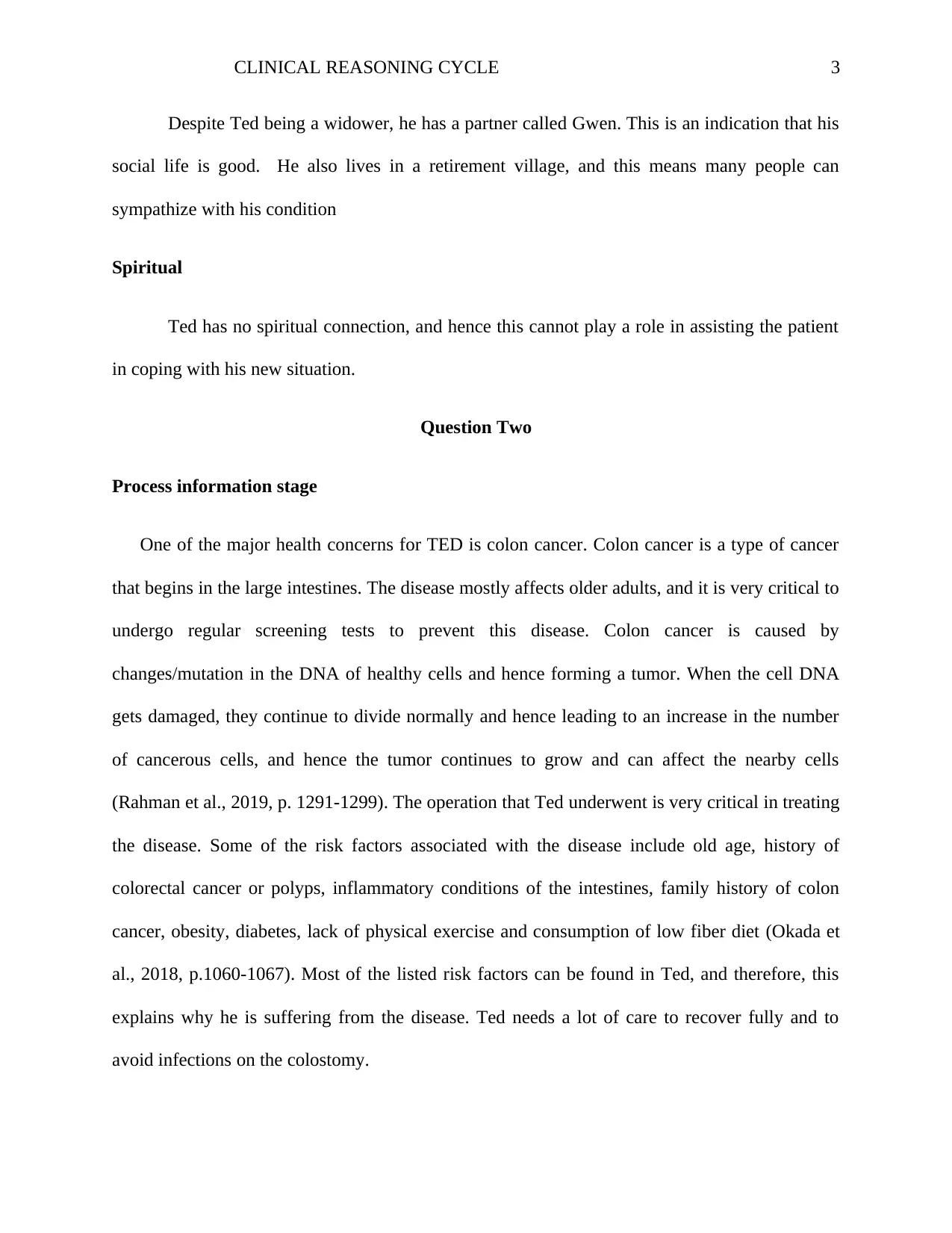
CLINICAL REASONING CYCLE 3
Despite Ted being a widower, he has a partner called Gwen. This is an indication that his
social life is good. He also lives in a retirement village, and this means many people can
sympathize with his condition
Spiritual
Ted has no spiritual connection, and hence this cannot play a role in assisting the patient
in coping with his new situation.
Question Two
Process information stage
One of the major health concerns for TED is colon cancer. Colon cancer is a type of cancer
that begins in the large intestines. The disease mostly affects older adults, and it is very critical to
undergo regular screening tests to prevent this disease. Colon cancer is caused by
changes/mutation in the DNA of healthy cells and hence forming a tumor. When the cell DNA
gets damaged, they continue to divide normally and hence leading to an increase in the number
of cancerous cells, and hence the tumor continues to grow and can affect the nearby cells
(Rahman et al., 2019, p. 1291-1299). The operation that Ted underwent is very critical in treating
the disease. Some of the risk factors associated with the disease include old age, history of
colorectal cancer or polyps, inflammatory conditions of the intestines, family history of colon
cancer, obesity, diabetes, lack of physical exercise and consumption of low fiber diet (Okada et
al., 2018, p.1060-1067). Most of the listed risk factors can be found in Ted, and therefore, this
explains why he is suffering from the disease. Ted needs a lot of care to recover fully and to
avoid infections on the colostomy.
Despite Ted being a widower, he has a partner called Gwen. This is an indication that his
social life is good. He also lives in a retirement village, and this means many people can
sympathize with his condition
Spiritual
Ted has no spiritual connection, and hence this cannot play a role in assisting the patient
in coping with his new situation.
Question Two
Process information stage
One of the major health concerns for TED is colon cancer. Colon cancer is a type of cancer
that begins in the large intestines. The disease mostly affects older adults, and it is very critical to
undergo regular screening tests to prevent this disease. Colon cancer is caused by
changes/mutation in the DNA of healthy cells and hence forming a tumor. When the cell DNA
gets damaged, they continue to divide normally and hence leading to an increase in the number
of cancerous cells, and hence the tumor continues to grow and can affect the nearby cells
(Rahman et al., 2019, p. 1291-1299). The operation that Ted underwent is very critical in treating
the disease. Some of the risk factors associated with the disease include old age, history of
colorectal cancer or polyps, inflammatory conditions of the intestines, family history of colon
cancer, obesity, diabetes, lack of physical exercise and consumption of low fiber diet (Okada et
al., 2018, p.1060-1067). Most of the listed risk factors can be found in Ted, and therefore, this
explains why he is suffering from the disease. Ted needs a lot of care to recover fully and to
avoid infections on the colostomy.
⊘ This is a preview!⊘
Do you want full access?
Subscribe today to unlock all pages.

Trusted by 1+ million students worldwide
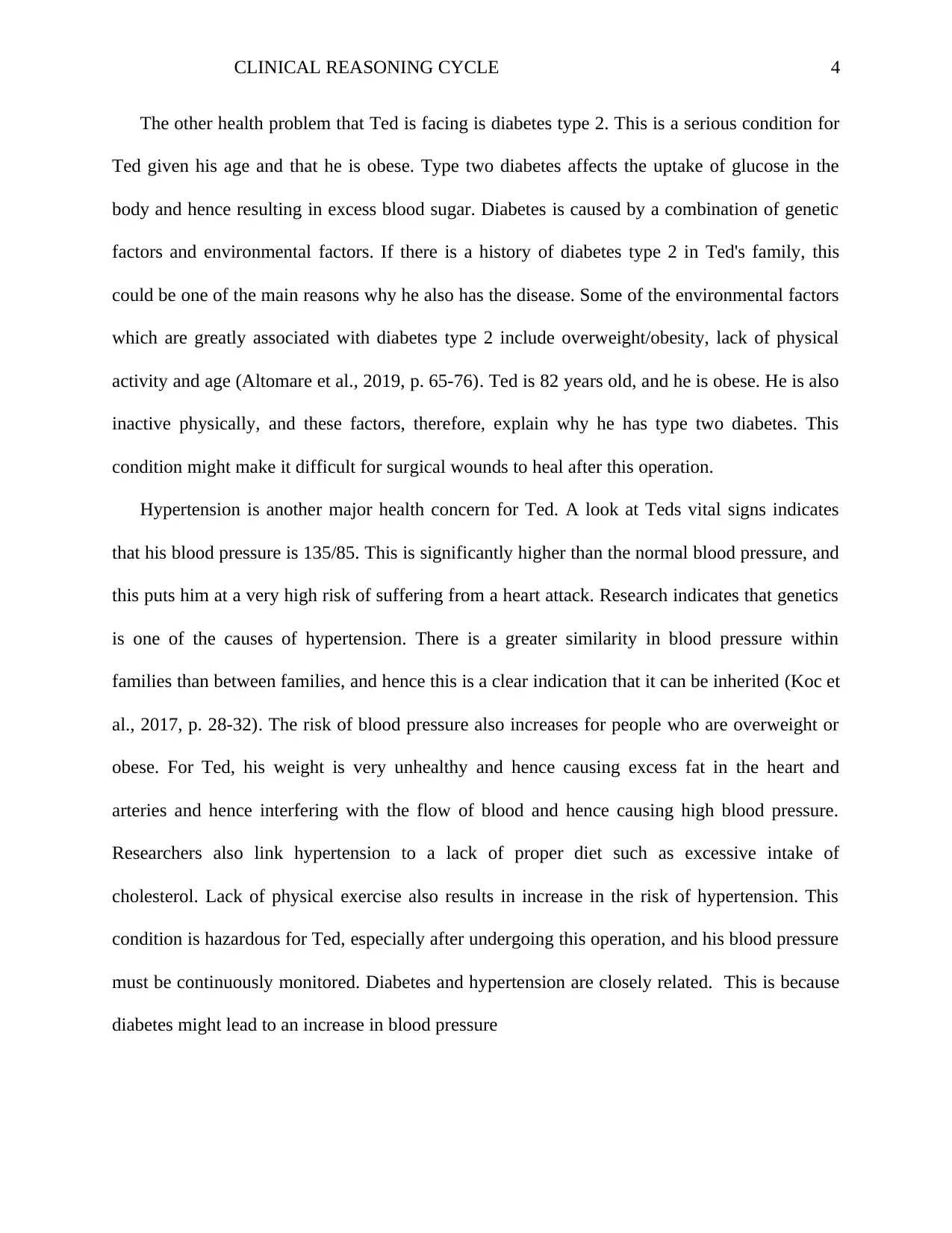
CLINICAL REASONING CYCLE 4
The other health problem that Ted is facing is diabetes type 2. This is a serious condition for
Ted given his age and that he is obese. Type two diabetes affects the uptake of glucose in the
body and hence resulting in excess blood sugar. Diabetes is caused by a combination of genetic
factors and environmental factors. If there is a history of diabetes type 2 in Ted's family, this
could be one of the main reasons why he also has the disease. Some of the environmental factors
which are greatly associated with diabetes type 2 include overweight/obesity, lack of physical
activity and age (Altomare et al., 2019, p. 65-76). Ted is 82 years old, and he is obese. He is also
inactive physically, and these factors, therefore, explain why he has type two diabetes. This
condition might make it difficult for surgical wounds to heal after this operation.
Hypertension is another major health concern for Ted. A look at Teds vital signs indicates
that his blood pressure is 135/85. This is significantly higher than the normal blood pressure, and
this puts him at a very high risk of suffering from a heart attack. Research indicates that genetics
is one of the causes of hypertension. There is a greater similarity in blood pressure within
families than between families, and hence this is a clear indication that it can be inherited (Koc et
al., 2017, p. 28-32). The risk of blood pressure also increases for people who are overweight or
obese. For Ted, his weight is very unhealthy and hence causing excess fat in the heart and
arteries and hence interfering with the flow of blood and hence causing high blood pressure.
Researchers also link hypertension to a lack of proper diet such as excessive intake of
cholesterol. Lack of physical exercise also results in increase in the risk of hypertension. This
condition is hazardous for Ted, especially after undergoing this operation, and his blood pressure
must be continuously monitored. Diabetes and hypertension are closely related. This is because
diabetes might lead to an increase in blood pressure
The other health problem that Ted is facing is diabetes type 2. This is a serious condition for
Ted given his age and that he is obese. Type two diabetes affects the uptake of glucose in the
body and hence resulting in excess blood sugar. Diabetes is caused by a combination of genetic
factors and environmental factors. If there is a history of diabetes type 2 in Ted's family, this
could be one of the main reasons why he also has the disease. Some of the environmental factors
which are greatly associated with diabetes type 2 include overweight/obesity, lack of physical
activity and age (Altomare et al., 2019, p. 65-76). Ted is 82 years old, and he is obese. He is also
inactive physically, and these factors, therefore, explain why he has type two diabetes. This
condition might make it difficult for surgical wounds to heal after this operation.
Hypertension is another major health concern for Ted. A look at Teds vital signs indicates
that his blood pressure is 135/85. This is significantly higher than the normal blood pressure, and
this puts him at a very high risk of suffering from a heart attack. Research indicates that genetics
is one of the causes of hypertension. There is a greater similarity in blood pressure within
families than between families, and hence this is a clear indication that it can be inherited (Koc et
al., 2017, p. 28-32). The risk of blood pressure also increases for people who are overweight or
obese. For Ted, his weight is very unhealthy and hence causing excess fat in the heart and
arteries and hence interfering with the flow of blood and hence causing high blood pressure.
Researchers also link hypertension to a lack of proper diet such as excessive intake of
cholesterol. Lack of physical exercise also results in increase in the risk of hypertension. This
condition is hazardous for Ted, especially after undergoing this operation, and his blood pressure
must be continuously monitored. Diabetes and hypertension are closely related. This is because
diabetes might lead to an increase in blood pressure
Paraphrase This Document
Need a fresh take? Get an instant paraphrase of this document with our AI Paraphraser
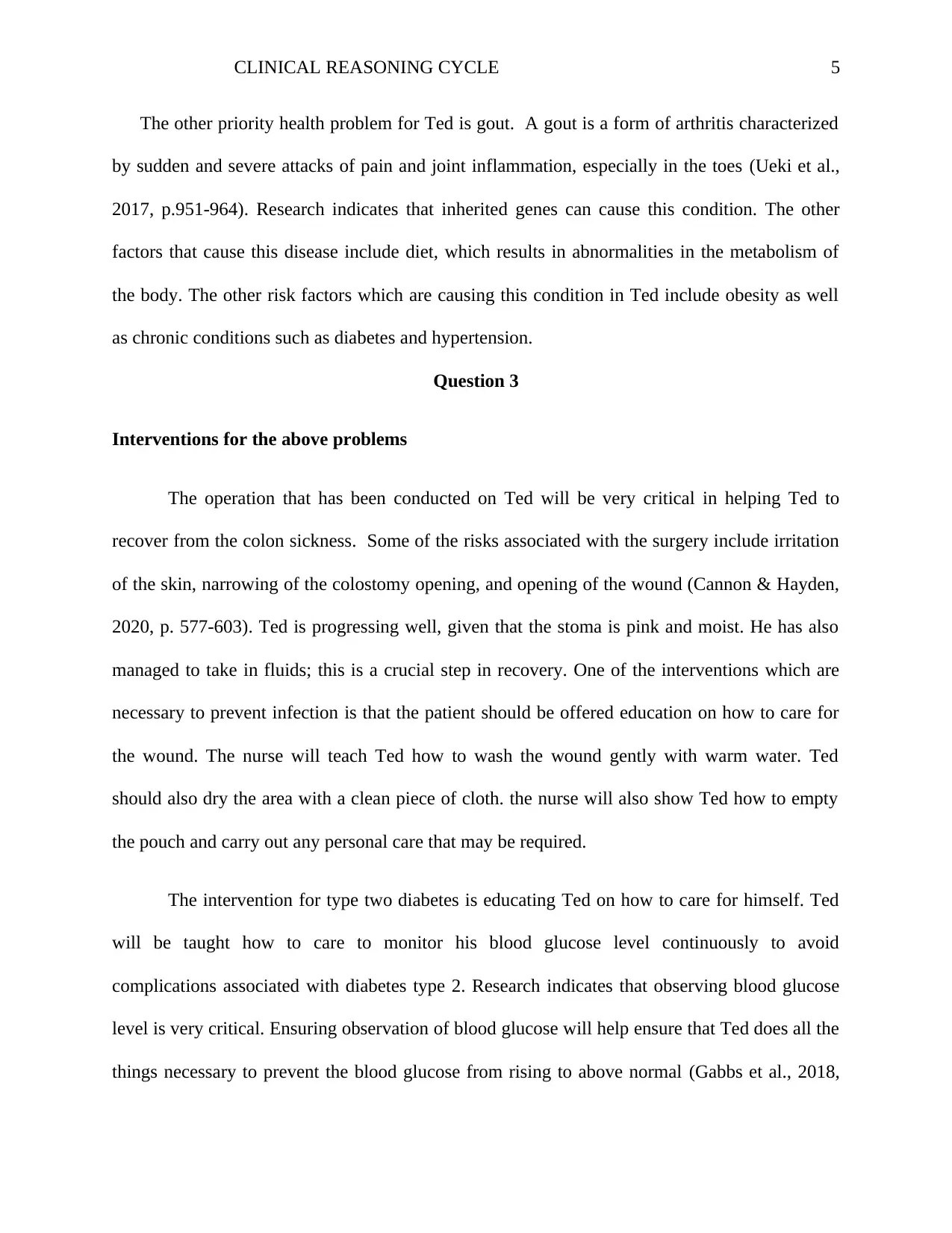
CLINICAL REASONING CYCLE 5
The other priority health problem for Ted is gout. A gout is a form of arthritis characterized
by sudden and severe attacks of pain and joint inflammation, especially in the toes (Ueki et al.,
2017, p.951-964). Research indicates that inherited genes can cause this condition. The other
factors that cause this disease include diet, which results in abnormalities in the metabolism of
the body. The other risk factors which are causing this condition in Ted include obesity as well
as chronic conditions such as diabetes and hypertension.
Question 3
Interventions for the above problems
The operation that has been conducted on Ted will be very critical in helping Ted to
recover from the colon sickness. Some of the risks associated with the surgery include irritation
of the skin, narrowing of the colostomy opening, and opening of the wound (Cannon & Hayden,
2020, p. 577-603). Ted is progressing well, given that the stoma is pink and moist. He has also
managed to take in fluids; this is a crucial step in recovery. One of the interventions which are
necessary to prevent infection is that the patient should be offered education on how to care for
the wound. The nurse will teach Ted how to wash the wound gently with warm water. Ted
should also dry the area with a clean piece of cloth. the nurse will also show Ted how to empty
the pouch and carry out any personal care that may be required.
The intervention for type two diabetes is educating Ted on how to care for himself. Ted
will be taught how to care to monitor his blood glucose level continuously to avoid
complications associated with diabetes type 2. Research indicates that observing blood glucose
level is very critical. Ensuring observation of blood glucose will help ensure that Ted does all the
things necessary to prevent the blood glucose from rising to above normal (Gabbs et al., 2018,
The other priority health problem for Ted is gout. A gout is a form of arthritis characterized
by sudden and severe attacks of pain and joint inflammation, especially in the toes (Ueki et al.,
2017, p.951-964). Research indicates that inherited genes can cause this condition. The other
factors that cause this disease include diet, which results in abnormalities in the metabolism of
the body. The other risk factors which are causing this condition in Ted include obesity as well
as chronic conditions such as diabetes and hypertension.
Question 3
Interventions for the above problems
The operation that has been conducted on Ted will be very critical in helping Ted to
recover from the colon sickness. Some of the risks associated with the surgery include irritation
of the skin, narrowing of the colostomy opening, and opening of the wound (Cannon & Hayden,
2020, p. 577-603). Ted is progressing well, given that the stoma is pink and moist. He has also
managed to take in fluids; this is a crucial step in recovery. One of the interventions which are
necessary to prevent infection is that the patient should be offered education on how to care for
the wound. The nurse will teach Ted how to wash the wound gently with warm water. Ted
should also dry the area with a clean piece of cloth. the nurse will also show Ted how to empty
the pouch and carry out any personal care that may be required.
The intervention for type two diabetes is educating Ted on how to care for himself. Ted
will be taught how to care to monitor his blood glucose level continuously to avoid
complications associated with diabetes type 2. Research indicates that observing blood glucose
level is very critical. Ensuring observation of blood glucose will help ensure that Ted does all the
things necessary to prevent the blood glucose from rising to above normal (Gabbs et al., 2018,
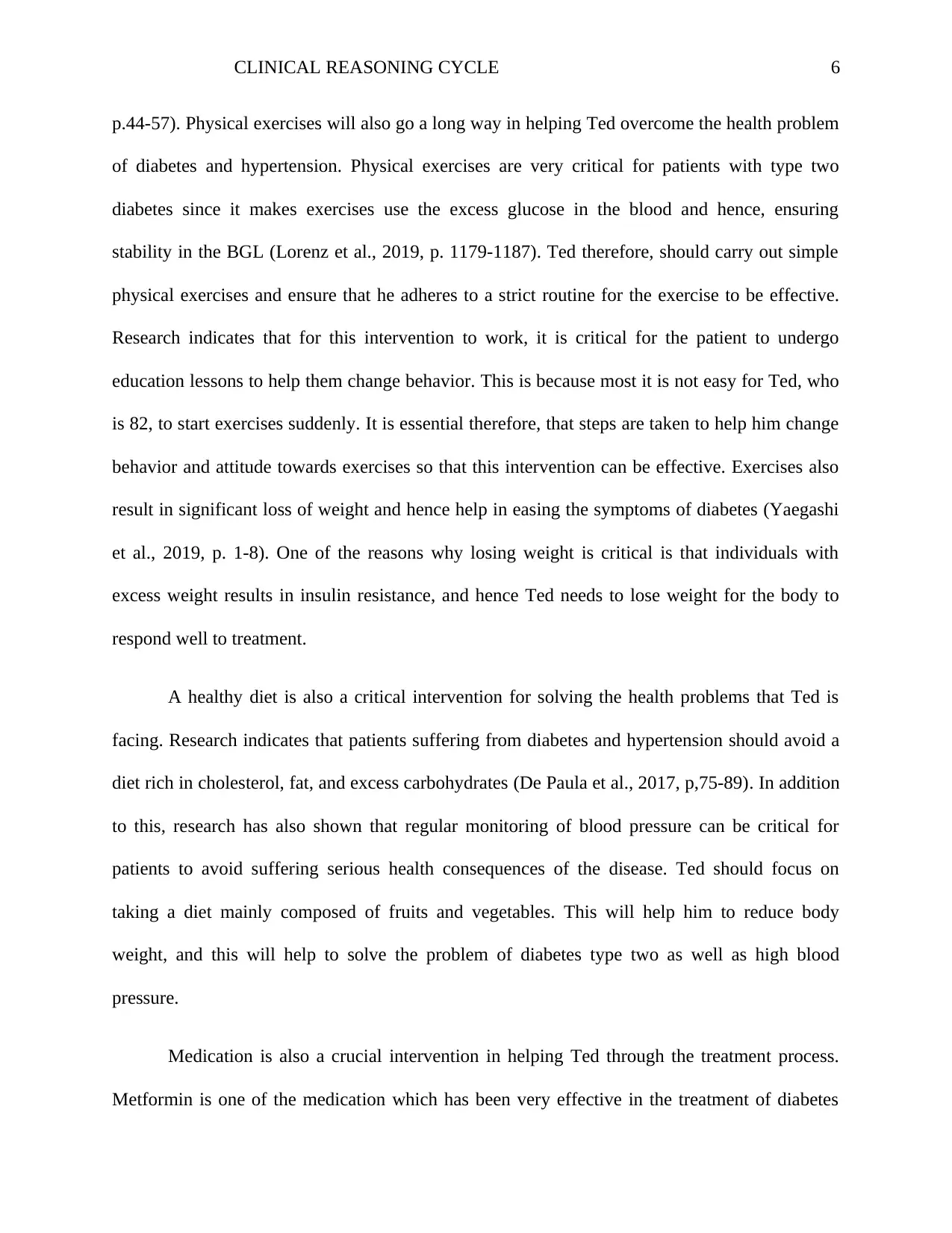
CLINICAL REASONING CYCLE 6
p.44-57). Physical exercises will also go a long way in helping Ted overcome the health problem
of diabetes and hypertension. Physical exercises are very critical for patients with type two
diabetes since it makes exercises use the excess glucose in the blood and hence, ensuring
stability in the BGL (Lorenz et al., 2019, p. 1179-1187). Ted therefore, should carry out simple
physical exercises and ensure that he adheres to a strict routine for the exercise to be effective.
Research indicates that for this intervention to work, it is critical for the patient to undergo
education lessons to help them change behavior. This is because most it is not easy for Ted, who
is 82, to start exercises suddenly. It is essential therefore, that steps are taken to help him change
behavior and attitude towards exercises so that this intervention can be effective. Exercises also
result in significant loss of weight and hence help in easing the symptoms of diabetes (Yaegashi
et al., 2019, p. 1-8). One of the reasons why losing weight is critical is that individuals with
excess weight results in insulin resistance, and hence Ted needs to lose weight for the body to
respond well to treatment.
A healthy diet is also a critical intervention for solving the health problems that Ted is
facing. Research indicates that patients suffering from diabetes and hypertension should avoid a
diet rich in cholesterol, fat, and excess carbohydrates (De Paula et al., 2017, p,75-89). In addition
to this, research has also shown that regular monitoring of blood pressure can be critical for
patients to avoid suffering serious health consequences of the disease. Ted should focus on
taking a diet mainly composed of fruits and vegetables. This will help him to reduce body
weight, and this will help to solve the problem of diabetes type two as well as high blood
pressure.
Medication is also a crucial intervention in helping Ted through the treatment process.
Metformin is one of the medication which has been very effective in the treatment of diabetes
p.44-57). Physical exercises will also go a long way in helping Ted overcome the health problem
of diabetes and hypertension. Physical exercises are very critical for patients with type two
diabetes since it makes exercises use the excess glucose in the blood and hence, ensuring
stability in the BGL (Lorenz et al., 2019, p. 1179-1187). Ted therefore, should carry out simple
physical exercises and ensure that he adheres to a strict routine for the exercise to be effective.
Research indicates that for this intervention to work, it is critical for the patient to undergo
education lessons to help them change behavior. This is because most it is not easy for Ted, who
is 82, to start exercises suddenly. It is essential therefore, that steps are taken to help him change
behavior and attitude towards exercises so that this intervention can be effective. Exercises also
result in significant loss of weight and hence help in easing the symptoms of diabetes (Yaegashi
et al., 2019, p. 1-8). One of the reasons why losing weight is critical is that individuals with
excess weight results in insulin resistance, and hence Ted needs to lose weight for the body to
respond well to treatment.
A healthy diet is also a critical intervention for solving the health problems that Ted is
facing. Research indicates that patients suffering from diabetes and hypertension should avoid a
diet rich in cholesterol, fat, and excess carbohydrates (De Paula et al., 2017, p,75-89). In addition
to this, research has also shown that regular monitoring of blood pressure can be critical for
patients to avoid suffering serious health consequences of the disease. Ted should focus on
taking a diet mainly composed of fruits and vegetables. This will help him to reduce body
weight, and this will help to solve the problem of diabetes type two as well as high blood
pressure.
Medication is also a crucial intervention in helping Ted through the treatment process.
Metformin is one of the medication which has been very effective in the treatment of diabetes
⊘ This is a preview!⊘
Do you want full access?
Subscribe today to unlock all pages.

Trusted by 1+ million students worldwide
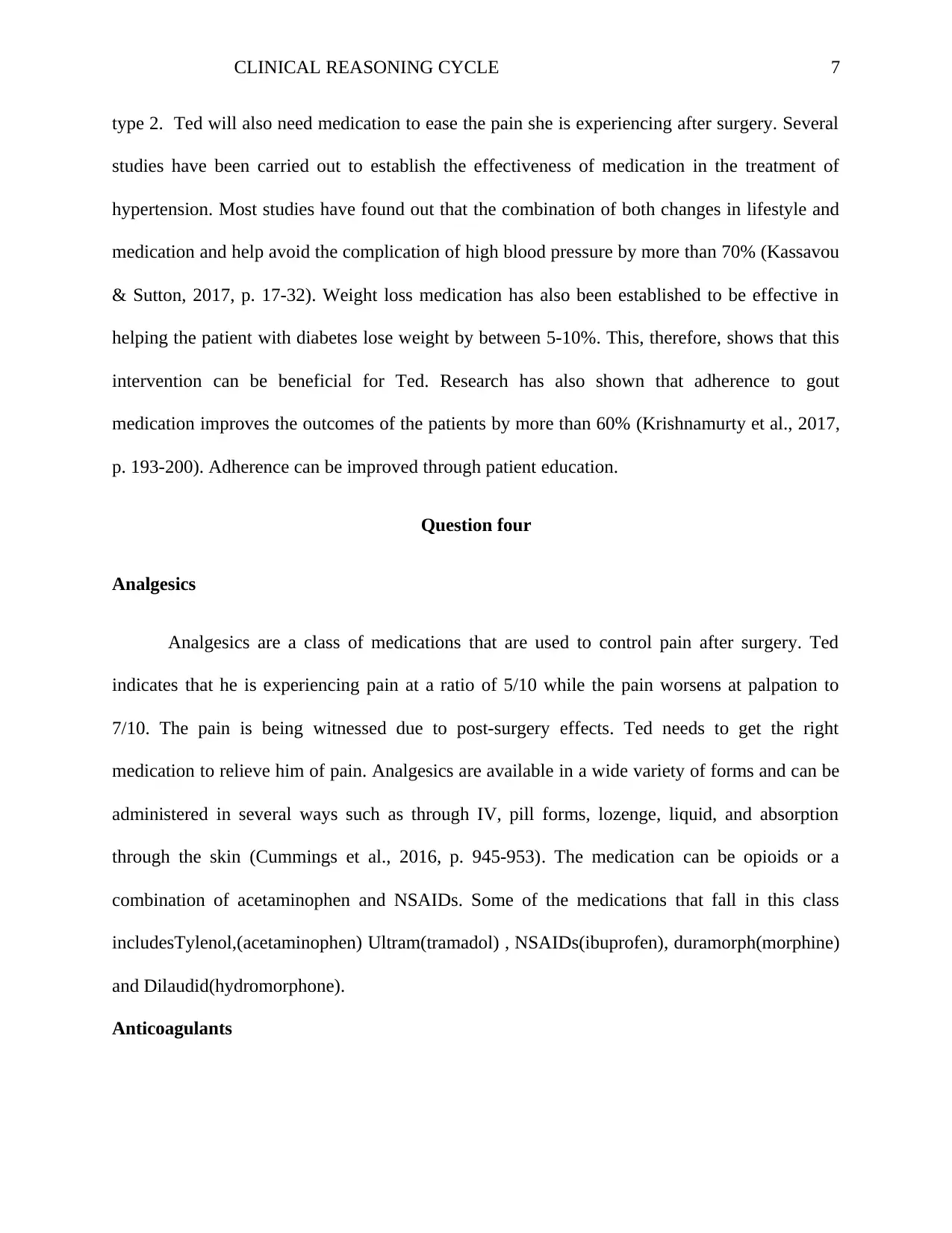
CLINICAL REASONING CYCLE 7
type 2. Ted will also need medication to ease the pain she is experiencing after surgery. Several
studies have been carried out to establish the effectiveness of medication in the treatment of
hypertension. Most studies have found out that the combination of both changes in lifestyle and
medication and help avoid the complication of high blood pressure by more than 70% (Kassavou
& Sutton, 2017, p. 17-32). Weight loss medication has also been established to be effective in
helping the patient with diabetes lose weight by between 5-10%. This, therefore, shows that this
intervention can be beneficial for Ted. Research has also shown that adherence to gout
medication improves the outcomes of the patients by more than 60% (Krishnamurty et al., 2017,
p. 193-200). Adherence can be improved through patient education.
Question four
Analgesics
Analgesics are a class of medications that are used to control pain after surgery. Ted
indicates that he is experiencing pain at a ratio of 5/10 while the pain worsens at palpation to
7/10. The pain is being witnessed due to post-surgery effects. Ted needs to get the right
medication to relieve him of pain. Analgesics are available in a wide variety of forms and can be
administered in several ways such as through IV, pill forms, lozenge, liquid, and absorption
through the skin (Cummings et al., 2016, p. 945-953). The medication can be opioids or a
combination of acetaminophen and NSAIDs. Some of the medications that fall in this class
includesTylenol,(acetaminophen) Ultram(tramadol) , NSAIDs(ibuprofen), duramorph(morphine)
and Dilaudid(hydromorphone).
Anticoagulants
type 2. Ted will also need medication to ease the pain she is experiencing after surgery. Several
studies have been carried out to establish the effectiveness of medication in the treatment of
hypertension. Most studies have found out that the combination of both changes in lifestyle and
medication and help avoid the complication of high blood pressure by more than 70% (Kassavou
& Sutton, 2017, p. 17-32). Weight loss medication has also been established to be effective in
helping the patient with diabetes lose weight by between 5-10%. This, therefore, shows that this
intervention can be beneficial for Ted. Research has also shown that adherence to gout
medication improves the outcomes of the patients by more than 60% (Krishnamurty et al., 2017,
p. 193-200). Adherence can be improved through patient education.
Question four
Analgesics
Analgesics are a class of medications that are used to control pain after surgery. Ted
indicates that he is experiencing pain at a ratio of 5/10 while the pain worsens at palpation to
7/10. The pain is being witnessed due to post-surgery effects. Ted needs to get the right
medication to relieve him of pain. Analgesics are available in a wide variety of forms and can be
administered in several ways such as through IV, pill forms, lozenge, liquid, and absorption
through the skin (Cummings et al., 2016, p. 945-953). The medication can be opioids or a
combination of acetaminophen and NSAIDs. Some of the medications that fall in this class
includesTylenol,(acetaminophen) Ultram(tramadol) , NSAIDs(ibuprofen), duramorph(morphine)
and Dilaudid(hydromorphone).
Anticoagulants
Paraphrase This Document
Need a fresh take? Get an instant paraphrase of this document with our AI Paraphraser
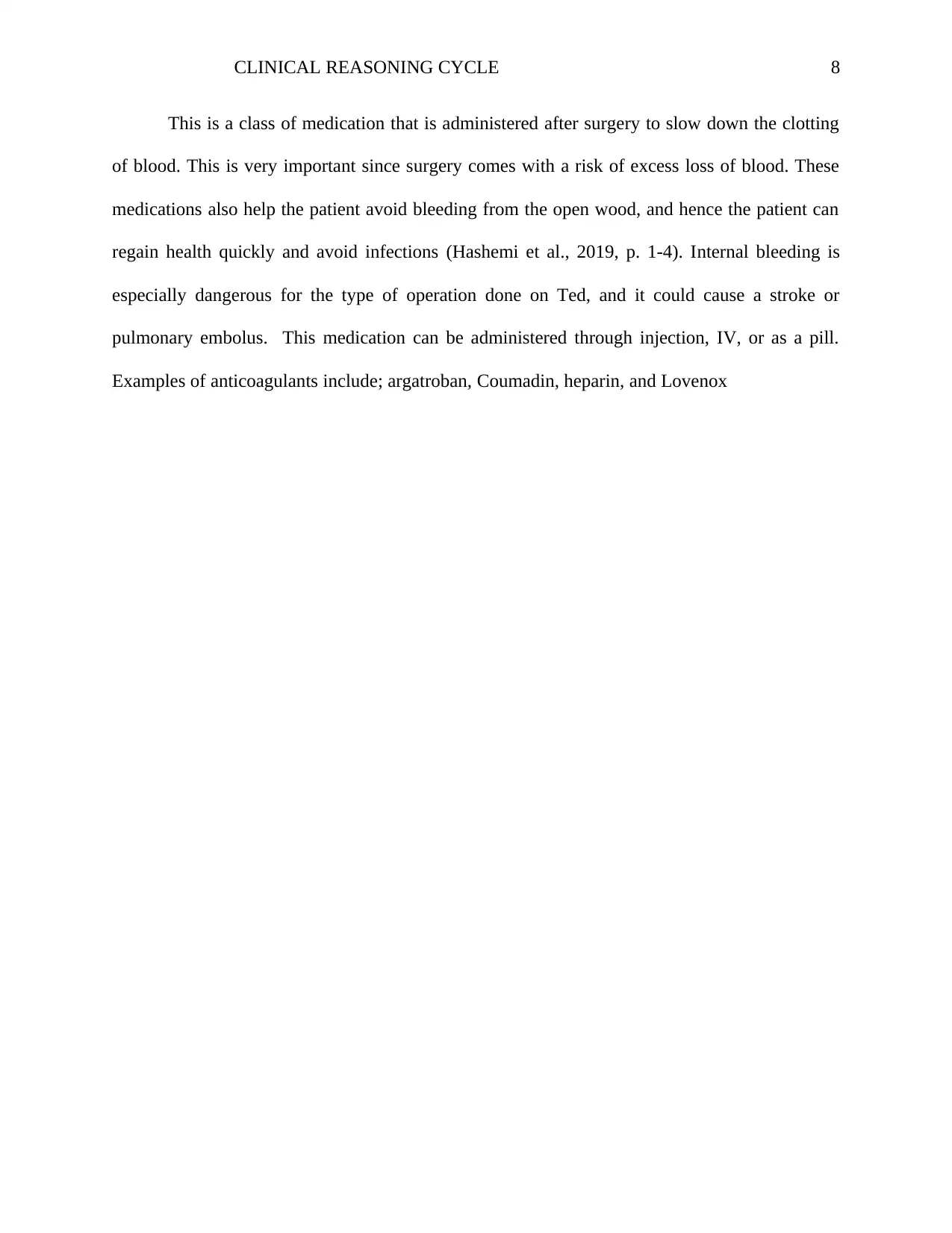
CLINICAL REASONING CYCLE 8
This is a class of medication that is administered after surgery to slow down the clotting
of blood. This is very important since surgery comes with a risk of excess loss of blood. These
medications also help the patient avoid bleeding from the open wood, and hence the patient can
regain health quickly and avoid infections (Hashemi et al., 2019, p. 1-4). Internal bleeding is
especially dangerous for the type of operation done on Ted, and it could cause a stroke or
pulmonary embolus. This medication can be administered through injection, IV, or as a pill.
Examples of anticoagulants include; argatroban, Coumadin, heparin, and Lovenox
This is a class of medication that is administered after surgery to slow down the clotting
of blood. This is very important since surgery comes with a risk of excess loss of blood. These
medications also help the patient avoid bleeding from the open wood, and hence the patient can
regain health quickly and avoid infections (Hashemi et al., 2019, p. 1-4). Internal bleeding is
especially dangerous for the type of operation done on Ted, and it could cause a stroke or
pulmonary embolus. This medication can be administered through injection, IV, or as a pill.
Examples of anticoagulants include; argatroban, Coumadin, heparin, and Lovenox
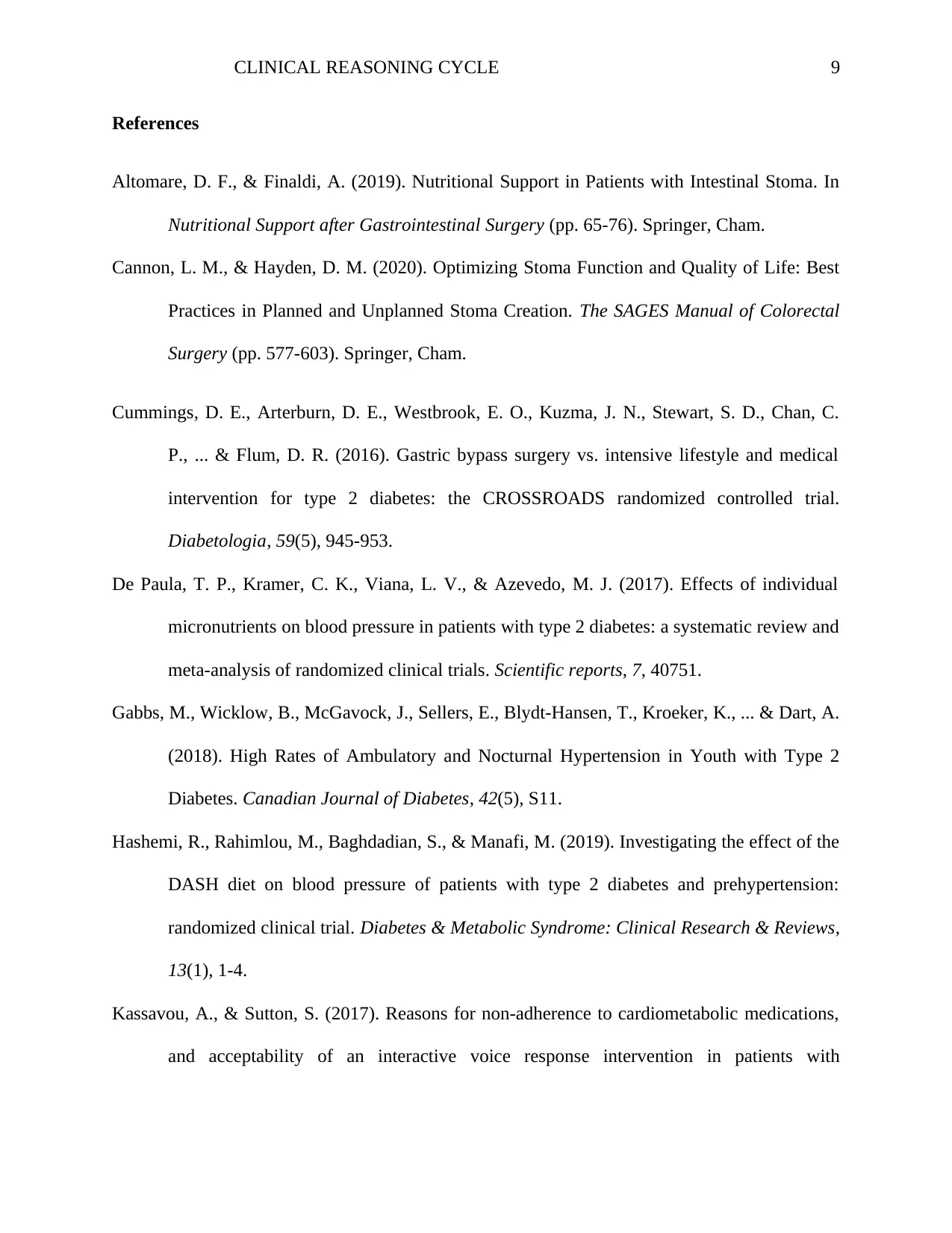
CLINICAL REASONING CYCLE 9
References
Altomare, D. F., & Finaldi, A. (2019). Nutritional Support in Patients with Intestinal Stoma. In
Nutritional Support after Gastrointestinal Surgery (pp. 65-76). Springer, Cham.
Cannon, L. M., & Hayden, D. M. (2020). Optimizing Stoma Function and Quality of Life: Best
Practices in Planned and Unplanned Stoma Creation. The SAGES Manual of Colorectal
Surgery (pp. 577-603). Springer, Cham.
Cummings, D. E., Arterburn, D. E., Westbrook, E. O., Kuzma, J. N., Stewart, S. D., Chan, C.
P., ... & Flum, D. R. (2016). Gastric bypass surgery vs. intensive lifestyle and medical
intervention for type 2 diabetes: the CROSSROADS randomized controlled trial.
Diabetologia, 59(5), 945-953.
De Paula, T. P., Kramer, C. K., Viana, L. V., & Azevedo, M. J. (2017). Effects of individual
micronutrients on blood pressure in patients with type 2 diabetes: a systematic review and
meta-analysis of randomized clinical trials. Scientific reports, 7, 40751.
Gabbs, M., Wicklow, B., McGavock, J., Sellers, E., Blydt-Hansen, T., Kroeker, K., ... & Dart, A.
(2018). High Rates of Ambulatory and Nocturnal Hypertension in Youth with Type 2
Diabetes. Canadian Journal of Diabetes, 42(5), S11.
Hashemi, R., Rahimlou, M., Baghdadian, S., & Manafi, M. (2019). Investigating the effect of the
DASH diet on blood pressure of patients with type 2 diabetes and prehypertension:
randomized clinical trial. Diabetes & Metabolic Syndrome: Clinical Research & Reviews,
13(1), 1-4.
Kassavou, A., & Sutton, S. (2017). Reasons for non-adherence to cardiometabolic medications,
and acceptability of an interactive voice response intervention in patients with
References
Altomare, D. F., & Finaldi, A. (2019). Nutritional Support in Patients with Intestinal Stoma. In
Nutritional Support after Gastrointestinal Surgery (pp. 65-76). Springer, Cham.
Cannon, L. M., & Hayden, D. M. (2020). Optimizing Stoma Function and Quality of Life: Best
Practices in Planned and Unplanned Stoma Creation. The SAGES Manual of Colorectal
Surgery (pp. 577-603). Springer, Cham.
Cummings, D. E., Arterburn, D. E., Westbrook, E. O., Kuzma, J. N., Stewart, S. D., Chan, C.
P., ... & Flum, D. R. (2016). Gastric bypass surgery vs. intensive lifestyle and medical
intervention for type 2 diabetes: the CROSSROADS randomized controlled trial.
Diabetologia, 59(5), 945-953.
De Paula, T. P., Kramer, C. K., Viana, L. V., & Azevedo, M. J. (2017). Effects of individual
micronutrients on blood pressure in patients with type 2 diabetes: a systematic review and
meta-analysis of randomized clinical trials. Scientific reports, 7, 40751.
Gabbs, M., Wicklow, B., McGavock, J., Sellers, E., Blydt-Hansen, T., Kroeker, K., ... & Dart, A.
(2018). High Rates of Ambulatory and Nocturnal Hypertension in Youth with Type 2
Diabetes. Canadian Journal of Diabetes, 42(5), S11.
Hashemi, R., Rahimlou, M., Baghdadian, S., & Manafi, M. (2019). Investigating the effect of the
DASH diet on blood pressure of patients with type 2 diabetes and prehypertension:
randomized clinical trial. Diabetes & Metabolic Syndrome: Clinical Research & Reviews,
13(1), 1-4.
Kassavou, A., & Sutton, S. (2017). Reasons for non-adherence to cardiometabolic medications,
and acceptability of an interactive voice response intervention in patients with
⊘ This is a preview!⊘
Do you want full access?
Subscribe today to unlock all pages.

Trusted by 1+ million students worldwide
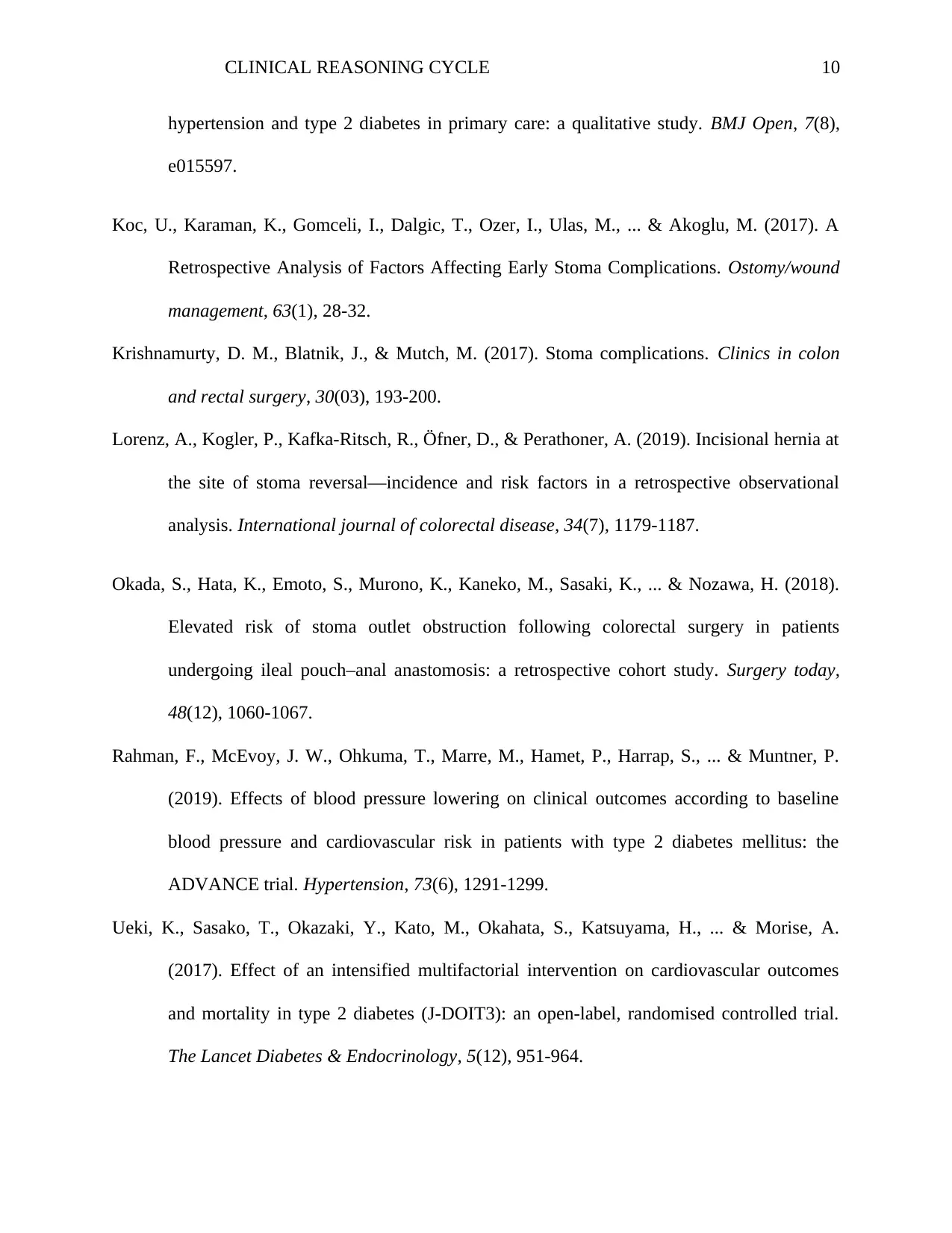
CLINICAL REASONING CYCLE 10
hypertension and type 2 diabetes in primary care: a qualitative study. BMJ Open, 7(8),
e015597.
Koc, U., Karaman, K., Gomceli, I., Dalgic, T., Ozer, I., Ulas, M., ... & Akoglu, M. (2017). A
Retrospective Analysis of Factors Affecting Early Stoma Complications. Ostomy/wound
management, 63(1), 28-32.
Krishnamurty, D. M., Blatnik, J., & Mutch, M. (2017). Stoma complications. Clinics in colon
and rectal surgery, 30(03), 193-200.
Lorenz, A., Kogler, P., Kafka-Ritsch, R., Öfner, D., & Perathoner, A. (2019). Incisional hernia at
the site of stoma reversal—incidence and risk factors in a retrospective observational
analysis. International journal of colorectal disease, 34(7), 1179-1187.
Okada, S., Hata, K., Emoto, S., Murono, K., Kaneko, M., Sasaki, K., ... & Nozawa, H. (2018).
Elevated risk of stoma outlet obstruction following colorectal surgery in patients
undergoing ileal pouch–anal anastomosis: a retrospective cohort study. Surgery today,
48(12), 1060-1067.
Rahman, F., McEvoy, J. W., Ohkuma, T., Marre, M., Hamet, P., Harrap, S., ... & Muntner, P.
(2019). Effects of blood pressure lowering on clinical outcomes according to baseline
blood pressure and cardiovascular risk in patients with type 2 diabetes mellitus: the
ADVANCE trial. Hypertension, 73(6), 1291-1299.
Ueki, K., Sasako, T., Okazaki, Y., Kato, M., Okahata, S., Katsuyama, H., ... & Morise, A.
(2017). Effect of an intensified multifactorial intervention on cardiovascular outcomes
and mortality in type 2 diabetes (J-DOIT3): an open-label, randomised controlled trial.
The Lancet Diabetes & Endocrinology, 5(12), 951-964.
hypertension and type 2 diabetes in primary care: a qualitative study. BMJ Open, 7(8),
e015597.
Koc, U., Karaman, K., Gomceli, I., Dalgic, T., Ozer, I., Ulas, M., ... & Akoglu, M. (2017). A
Retrospective Analysis of Factors Affecting Early Stoma Complications. Ostomy/wound
management, 63(1), 28-32.
Krishnamurty, D. M., Blatnik, J., & Mutch, M. (2017). Stoma complications. Clinics in colon
and rectal surgery, 30(03), 193-200.
Lorenz, A., Kogler, P., Kafka-Ritsch, R., Öfner, D., & Perathoner, A. (2019). Incisional hernia at
the site of stoma reversal—incidence and risk factors in a retrospective observational
analysis. International journal of colorectal disease, 34(7), 1179-1187.
Okada, S., Hata, K., Emoto, S., Murono, K., Kaneko, M., Sasaki, K., ... & Nozawa, H. (2018).
Elevated risk of stoma outlet obstruction following colorectal surgery in patients
undergoing ileal pouch–anal anastomosis: a retrospective cohort study. Surgery today,
48(12), 1060-1067.
Rahman, F., McEvoy, J. W., Ohkuma, T., Marre, M., Hamet, P., Harrap, S., ... & Muntner, P.
(2019). Effects of blood pressure lowering on clinical outcomes according to baseline
blood pressure and cardiovascular risk in patients with type 2 diabetes mellitus: the
ADVANCE trial. Hypertension, 73(6), 1291-1299.
Ueki, K., Sasako, T., Okazaki, Y., Kato, M., Okahata, S., Katsuyama, H., ... & Morise, A.
(2017). Effect of an intensified multifactorial intervention on cardiovascular outcomes
and mortality in type 2 diabetes (J-DOIT3): an open-label, randomised controlled trial.
The Lancet Diabetes & Endocrinology, 5(12), 951-964.
Paraphrase This Document
Need a fresh take? Get an instant paraphrase of this document with our AI Paraphraser
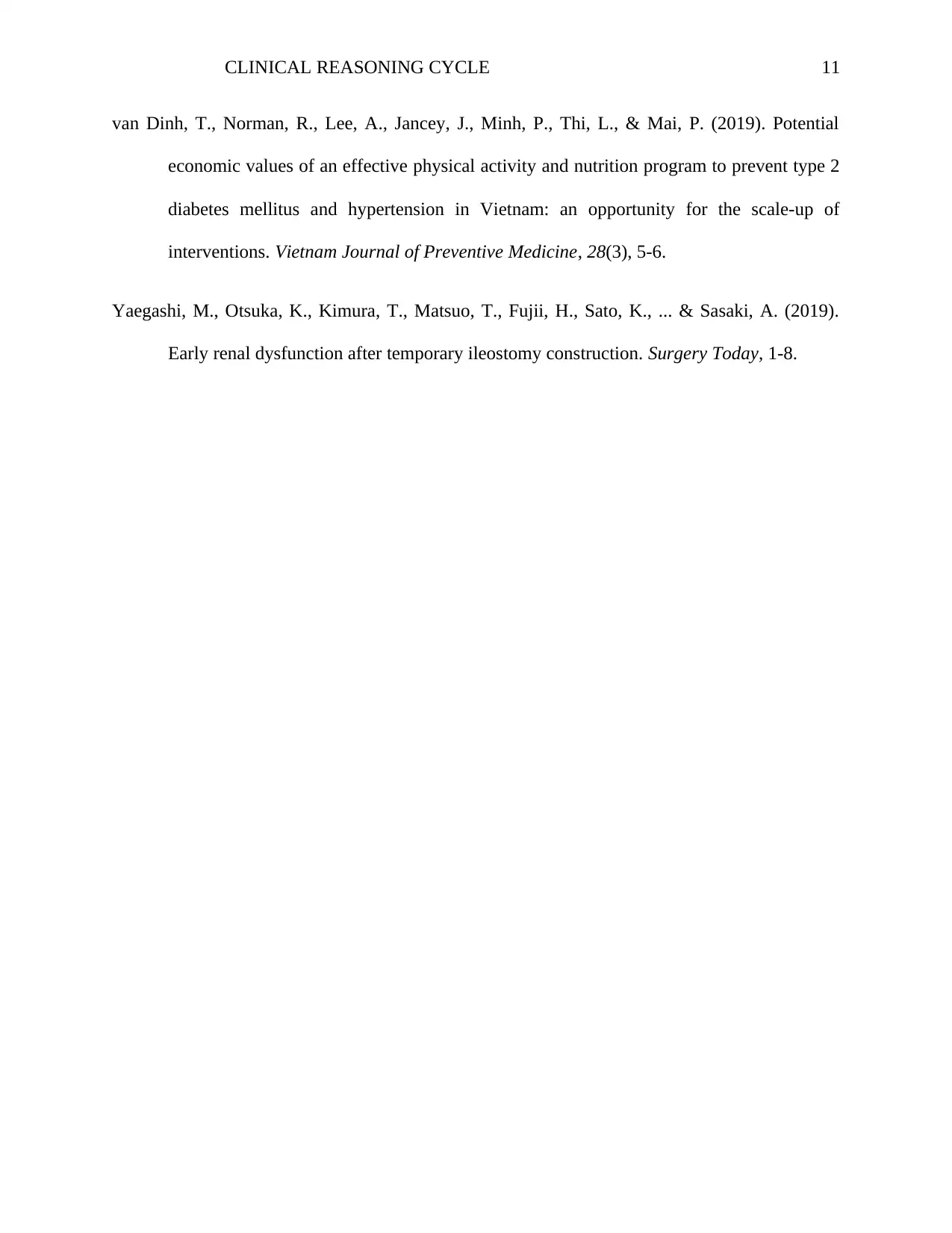
CLINICAL REASONING CYCLE 11
van Dinh, T., Norman, R., Lee, A., Jancey, J., Minh, P., Thi, L., & Mai, P. (2019). Potential
economic values of an effective physical activity and nutrition program to prevent type 2
diabetes mellitus and hypertension in Vietnam: an opportunity for the scale-up of
interventions. Vietnam Journal of Preventive Medicine, 28(3), 5-6.
Yaegashi, M., Otsuka, K., Kimura, T., Matsuo, T., Fujii, H., Sato, K., ... & Sasaki, A. (2019).
Early renal dysfunction after temporary ileostomy construction. Surgery Today, 1-8.
van Dinh, T., Norman, R., Lee, A., Jancey, J., Minh, P., Thi, L., & Mai, P. (2019). Potential
economic values of an effective physical activity and nutrition program to prevent type 2
diabetes mellitus and hypertension in Vietnam: an opportunity for the scale-up of
interventions. Vietnam Journal of Preventive Medicine, 28(3), 5-6.
Yaegashi, M., Otsuka, K., Kimura, T., Matsuo, T., Fujii, H., Sato, K., ... & Sasaki, A. (2019).
Early renal dysfunction after temporary ileostomy construction. Surgery Today, 1-8.
1 out of 11
Related Documents
Your All-in-One AI-Powered Toolkit for Academic Success.
+13062052269
info@desklib.com
Available 24*7 on WhatsApp / Email
![[object Object]](/_next/static/media/star-bottom.7253800d.svg)
Unlock your academic potential
Copyright © 2020–2025 A2Z Services. All Rights Reserved. Developed and managed by ZUCOL.





